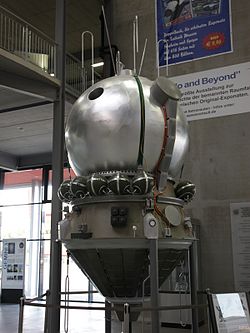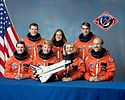STS-40
| STS-40 | |||||
 | |||||
| Uppdrag | 41 | ||||
|---|---|---|---|---|---|
| Rymdfärja | Columbia (11)[1] | ||||
| NSSDC-ID | 1991-040A[2] | ||||
| Färdens tid | 9 dagar, 2 timmar, 14 minuter, 20 sekunder | ||||
| Uppskjutning | |||||
| Startplats | Startplatta 39B vid Kennedy Space Center i Florida | ||||
| Start | 5 juni 1991, 9:24:51 a.m. EDT | ||||
| Landning | |||||
| Landningsplats | Runway 22, Edwards Air Force Base, Kalifornien | ||||
| Landning | 14 juni 1991, 8:39:11 a.m. PDT | ||||
| Omloppsbana | |||||
| Varv | 145 st[3] | ||||
| Apogeum | 296 km | ||||
| Perigeum | 287 km | ||||
| Banlutning | 39° | ||||
| Sträcka | 6,083 miljoner km | ||||
| Besättning | |||||
| Befälhavare | Bryan D. O'Connor (2) | ||||
| Pilot | Sidney M. Gutierrez (1) | ||||
| Uppdragsspecialister | James P. Bagian (2) Tamara E. Jernigan (1) M. Rhea Seddon (2) | ||||
| Nyttolastspecialister | F. Drew Gaffney (1) Millie Hughes-Fulford (1) | ||||
 | |||||
| Kronologi Rymdfärjeprogrammet | |||||
| |||||
STS-40 var den fyrtioförsta flygningen i det amerikanska rymdfärjeprogrammet, den elfte flygningen med rymdfärjan Columbia. Den sköts upp från Pad 39B vid Kennedy Space Center i Florida den 5 juni 1991. Efter drygt nio dagar i omloppsbana runt jorden återinträdde rymdfärjan i jordens atmosfär och landade vid Edwards Air Force Base i Kalifornien.
Se även
Referenser
- ^ NASA Space Shuttle Launch Archive Arkiverad 21 april 2012 hämtat från the Wayback Machine., läst 28 juli 2016.
- ^ ”NASA Space Science Data Coordinated Archive” (på engelska). NASA. https://nssdc.gsfc.nasa.gov/nmc/spacecraft/display.action?id=1991-040A. Läst 18 mars 2020.
- ^ Manned Astronautics - Figures & Facts Arkiverad 10 mars 2016 hämtat från the Wayback Machine., läst 28 juli 2016.
Externa länkar
 Wikimedia Commons har media som rör STS-40.
Wikimedia Commons har media som rör STS-40.
| ||||||||
| ||||||||||||||||||||||||||||||||
Media som används på denna webbplats
Författare/Upphovsman: Pascal (Flickr user: pasukaru76), Licens: CC0
Vostok spacecraft replica at the Technik Museum Speyer, Germany.
STS-40 Mission Insignia
The STS-40 crew portrait includes 7 astronauts. Pictured on the front row from left to right are F. Drew Gaffney, payload specialist 1; Milli-Hughes Fulford, payload specialist 2; M. Rhea Seddon, mission specialist 3; and James P. Bagian, mission specialist 1. Standing in the rear, left to right, are Bryan D. O'Connor, commander; Tamara E. Jernigan, mission specialist 2; and Sidney M. Gutierrez, pilot. Launched aboard the Space Shuttle Columbia on June 5, 1991 at 9:24; am (EDT), the STS-40 mission was the fifth dedicated Spacelab Mission, Spacelab Life Sciences-1 (SLS-1), and the first mission dedicated solely to life sciences.
STS-43 Mission Insignia
- Designed by the astronauts assigned to fly on the mission, the STS 43 patch portrays the evolution and continuity of the USA's space program by highlighting 30 years of American manned space flight experience -- from Mercury to the Space Shuttle. The emergence of the Shuttle Atlantis from the outlined configuration of the Mercury space capsule commemorates this special relationship. The energy and momentum of launch are conveyed by the gradations of blue which mark the Shuttle's ascent from Earth to space. Once in Earth orbit, Atlantis' cargo bay opens to reveal the Tracking and Data Relay Satellite (TDRS) which appears in gold emphasis against the white wings of Atlantis and the stark blackness of space. A primary mission objective, the Tracking and Data Relay Satellite System (TDRSS) will enable almost continuous communication from Earth to space for future Space Shuttle missions. The stars on the patch are arranged to suggest this mission's numerical designation, with four stars left of Atlantis and three to the right.
STS-39 Mission Insignia








